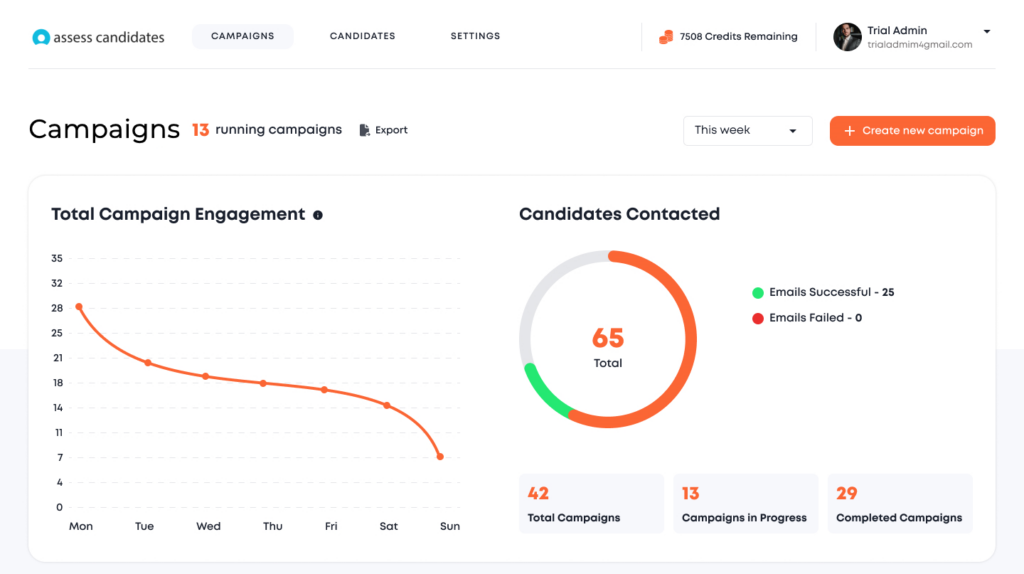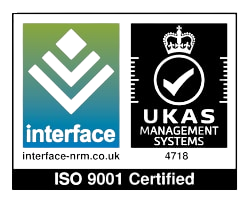Why ensuring your job assessment process is accessible to all candidates is crucial
Organizations, aiming for inclusive recruitment practices, must address specific accessibility concerns strategically. From online application platforms to job advertisements, interview processes, and assessment tests, each stage presents unique challenges for candidates with accessibility issues. Technology plays an increasingly integral role in recruitment, and using assessment tools that are both scientifically rigorous and universally accessible is key to success.
As organizations aspire to create inclusive recruitment practices, it’s crucial to focus on specific accessibility concerns. In the following sections, we’ll delve deeper into business reasons behind accessibility, as well as best practices for ensuring an accessible recruitment process. Join us as we uncover the strategic dimension of accessible recruitment.
Contents:
- What are the reasons for accessibility adjustments in recruitment?
- What specific accessibility concerns should employers be aware of?
- How to use assessment tools for accessible hiring?
- Why is Assess Candidates your number one choice for accessible and inclusive hiring?
- FAQs and Glossary of Terms
1. What are the reasons for accessibility adjustments in recruitment?
Legal frameworks, both national and international, provide the foundational basis for ensuring accessibility in recruitment. Failure to comply with these regulations not only poses legal risks but also hinders the goal of fostering a diverse and inclusive workforce. Employers that prioritize accessibility position themselves as leaders in creating diverse, innovative, and inclusive workplaces.

Let’s explore some of the key reasons why organizations should prioritize accessibility adjustments in their recruitment processes.
7 reasons to make accessibility adjustments in recruitment.
- Broader Talent Pool: Accessible recruitment processes open the door to a broader talent pool. By removing barriers, organizations can tap into the skills and potential of candidates from diverse backgrounds and abilities. This not only enriches the workplace with varied perspectives but also ensures that the best talent is not overlooked due to inaccessible processes.
An estimated 1.3 billion people – or 1 in 6 people worldwide – experience significant disability.
World Health Organization
- Reputation for Fairness and Inclusivity: Organizations that prioritize accessibility build a reputation for fairness and inclusivity. In today’s interconnected world, a positive reputation is a valuable asset. Candidates are increasingly drawn to employers who demonstrate a commitment to providing equal opportunities, and a reputation for fairness can enhance an organization’s attractiveness to top talent.
Companies who invest in diversity and accessibility initiatives are 73.2% more likely to attract top talent.
McKinsey
- Legal Compliance and Risk Mitigation: Adhering to accessibility requirements is not just about avoiding legal consequences; it is about mitigating risks. Non-compliance can result in legal actions, reputational damage, and a loss of potential talent. By proactively ensuring accessibility, organizations safeguard themselves against legal issues and demonstrate a commitment to ethical and responsible business practices.
- Enhanced Innovation and Creativity: An inclusive workforce, fostered through accessible recruitment, leads to enhanced innovation and creativity. Diverse teams bring a variety of perspectives, ideas, and problem-solving approaches. By creating an environment where all individuals can contribute their unique talents, organizations unlock the potential for groundbreaking innovation.
The companies that were leaders in inclusion and disability employment achieved on average 72% more productivity and 28% higher revenue than the rest of the cohort.
Accenture
- Improved Employee Morale and Engagement: A commitment to accessibility positively impacts employee morale and engagement. When employees perceive their workplace as inclusive and accommodating, it fosters a sense of belonging and loyalty. This, in turn, leads to increased job satisfaction, productivity, and a more positive organizational culture.
Hiring people with disabilities and embracing inclusivity leads to a 75% increase in employee productivity.
Entrepreneur.com
- Adaptability to Demographic Shifts: As demographics shift and the workforce becomes more diverse, organizations that prioritize accessibility are better positioned to adapt. By embracing inclusivity in recruitment, companies ensure they are equipped to navigate changes in the composition of the workforce and remain competitive in an evolving global landscape.
- Positive Impact on Corporate Culture: Accessibility adjustments contribute to the creation of a positive corporate culture. When employees witness an organizational commitment to inclusivity, it fosters a culture of empathy, understanding, and teamwork. A positive corporate culture, in turn, attracts and retains top talent and contributes to long-term organizational success.
Companies report that employees with disabilities have better retention rates, reducing the high cost of turnover.
United Nations
Hire using accessible pre-employment assessments for all. Hire For Free
2. What specific accessibility concerns should employers be aware of?
In this section, we explore the specific accessibility concerns that employers should be attuned to in the context of recruitment, with a focus on how addressing these concerns leads to positive outcomes. By understanding the specific needs associated with different abilities, employers can tailor their processes to provide equal opportunities for all candidates.
Let’s delve into various disabilities and explore the tailored accessibility adjustments that employers can make to the recruitment process.
4 examples of the most common accessibility adjustments.
- Visual Impairment: Visual impairment is a spectrum of conditions that affect a person’s ability to see, ranging from partial sight to total blindness. Job candidates with visual impairments navigate the world using various tools and techniques, such as screen readers, braille displays, and keyboard commands, to access digital content and information.
As many as 96% of website home pages contain Web Content Accessibility Guidelines failures. (WCAG is a set of parameters for measuring digital accessibility)
WebAim Million
- Hearing Impairment: Hearing impairment encompasses a range of conditions that impact an individual’s ability to hear, from partial hearing loss to complete deafness. Candidates with hearing impairments employ diverse tools, including hearing aids, cochlear implants, and communication techniques like sign language, to engage with the world around them. This may also involve providing candidates with visual cues that complement auditory information, and offering alternatives like written communication or sign language interpretation during interviews.
Approximately 42% of people with disabilities think that web content accessibility has not changed over the previous year.
WebAIM
- Cognitive Disabilities: Cognitive disabilities encompass a range of conditions affecting cognitive functions such as memory, attention, and problem-solving. Individuals with cognitive disabilities may face challenges in processing information or responding to stimuli in traditional ways. To enhance accessibility, employers can simplify language in job advertisements and assessments, offer clear and concise hiring instructions, and provide additional time or alternative formats for assessments.
If just 1% of unemployed people with disabilities joined the workforce, the result would be a $25 billion increase in the national GDP.
Disability:IN
- Physical Disabilities: Physical disabilities involve limitations in mobility or physical function, ranging from mild impairments to more severe conditions. Individuals with physical disabilities may use mobility aids, such as wheelchairs or crutches, to navigate their surroundings. The physical layout of spaces, inaccessible technology, or the lack of accommodations can pose challenges for candidates with physical disabilities during the application process. Ensuring physical accessibility is crucial for an inclusive experience.

3. How to use assessment tools for accessible hiring?
After seeing examples of different accessibility adjustments that can be made to the hiring process, in this section we will focus on the best practice strategies of using automated assessment tools in recruitment open to everyone.
By implementing these recommendations, organizations like yours can build a recruitment process that is truly inclusive and reflective of the diverse capabilities of the potential workforce.
11 steps for successful use of assessment tools for the accessible recruitment process.
- Time Flexibility: Allow for time flexibility in assessments. Some candidates may require additional time due to various disabilities, and accommodating this need ensures a fair evaluation process.
- Alternative Formats: Offer assessments in alternative formats. Some candidates may require materials in different formats, such as large print or Braille, to effectively engage with the content.
Companies that are diverse in terms of composition are 70% more likely to capture a new market than firms that are not diverse.
Harvard Business Review
- Captioning for Video Assessments: If video interviews are part of the evaluation process, ensure that they are captioned. Captioning makes the content accessible to candidates with hearing impairments.
- Compatibility with Screen Readers: Ensure that assessment tools are compatible with screen readers. Screen reader compatibility is crucial for candidates with visual impairments who rely on this technology to access digital content.
- Provide Accessibility Information: Clearly communicate the availability of accessibility features. Candidates should be informed about the accessibility options provided, allowing them to make use of the accommodations that best suit their needs.
Only 39% of individuals with disabilities felt comfortable disclosing their disability to their manager.
- Pilot Testing with Diverse Groups: Before implementing assessment tools, conduct pilot testing with diverse groups of individuals, including those with disabilities. Gather feedback to identify and address potential accessibility issues.
- Training for Assessors: Train assessors on accessibility awareness. Assessors should be equipped to recognize and address accessibility concerns, ensuring a fair and inclusive evaluation process.
- Regular Accessibility Audits: Conduct regular accessibility audits of assessment tools. Technology evolves, and regular audits help ensure that assessment tools remain accessible as updates or changes are implemented.
- Seek Candidate Feedback: Actively seek feedback from candidates on the accessibility of assessment tools. Candidate insights provide valuable information for continuous improvement in the accessibility of the recruitment process.
- Customizable Assessments: Provide options for customizable assessments. Some candidates may require adjustments based on their specific needs, and offering customizable assessments ensures a tailored and accessible experience.
- Continuous Improvement: Establish a culture of continuous improvement. Regularly assess and enhance the accessibility of assessment tools, keeping abreast of best practices and emerging technologies
Partner with Assess Candidates for accessible hiring. View Plans
4. Why is Assess Candidates your number one choice for accessible and inclusive hiring?
Choosing the right platform for candidate assessments is not just a matter of efficiency; it’s a strategic decision that shapes the inclusivity and diversity of your workforce. Assess Candidates stands out as the champion for accessible and inclusive hiring practices.
As the leader in accessible and inclusive hiring practices, Assess Candidates redefines the possibilities of candidate assessments. Grounded in psychometric research, powered by cutting-edge technology, and guided by a commitment to personalized support, Assess Candidates is not just a platform; it’s the recipe for your organizational success in diversity and accessibility.
3 Reasons to partner with Assess Candidates for accessible and inclusive hiring.
- Tools Grounded in Psychometric Research: At the heart of Assess Candidates lies a commitment to ensure that assessments are not only accurate indicators of candidates’ capabilities but also crafted with understanding of diversity and inclusion considerations. Our assessments are meticulously validated to ensure fair representation of skills and competencies across various demographic groups, fostering a level playing field for all candidates..
- Cutting-Edge Technology for Everyone: Our technology is redefining the meaning of accessibility in the industry. Our technology empowers organizations to tap into a broader talent pool, fostering an environment where every candidate, regardless of abilities, can showcase their true potential.
- Extended Time Options: This feature is designed to accommodate candidates who may require additional time due to factors such as disabilities, language proficiency, or other individual circumstances. By offering extended time options, we contribute to a more equitable assessment environment.

Practical example of Assess Candidates enhancing accessibility in your companies hiring process.
Client Problem:
Our client had previously administered assessment tools through a third-party vendor who introduced a variety of accessibility features. However, these were not communicated or explained to the recruiting team, who struggled to answer candidate’s questions. The conducting of initial interviews over a phone was also cited as a major drawback for many candidates.
Assess Candidates Solution:
When we introduced our platform to the client we provided a thorough training to the main decision makers in the business, crafting assessment communications with the hiring team. The biggest game changer was the introduction of Assess Candidates video interview technology – with an accessible platform and intuitive interface. Candidates favored the ease of this innovative technology and recruiters found this method to provide better evaluation of candidates than telephone interviews.
5. FAQs and Glossary of Terms
FAQs
- Why is there a call for accessibility adjustments in recruitment?
- The call for accessibility is not just a preference; it’s a legal and ethical imperative. Legal frameworks mandate accessibility, and organizations that prioritize it also enjoy strategic benefits, fostering diversity and creating innovative and inclusive workplaces.
- What legal frameworks set the stage for inclusivity in recruitment?
- National and international laws, such as the Americans with Disabilities Act (ADA) in the U.S. and the Equality Act in the U.K., mandate reasonable accommodations. Adhering to these laws is crucial for avoiding legal risks and fostering a diverse and inclusive workforce.
- What are the key reasons for accessibility adjustments in recruitment?
- Accessibility adjustments lead to a broader talent pool, a reputation for fairness, legal compliance and risk mitigation, enhanced innovation and creativity, improved employee morale and engagement, adaptability to demographic shifts, and a positive impact on corporate culture.
- What specific accessibility concerns should employers be aware of in recruitment?
- Employers should be attuned to accessibility concerns related to visual impairment, hearing impairment, cognitive disabilities, and physical disabilities across job application, online assessments, and video interviews. Tailoring adjustments for these concerns fosters an inclusive recruitment ecosystem.
- How can assessment tools be used for accessible hiring?
- Ensure clear and understandable instructions, provide time flexibility, embrace universal design principles, offer alternative formats, caption video assessments, ensure compatibility with screen readers, choose accessible assessment platforms, provide accessibility information, deliver feedback in accessible formats, conduct pilot testing, train assessors on accessibility, perform regular accessibility audits, seek candidate feedback, offer customizable assessments, and foster a culture of continuous improvement.
- What strategic benefits come from prioritizing accessibility in recruitment?
- Prioritizing accessibility not only ensures legal compliance but also opens doors to a broader talent pool, builds a reputation for fairness and inclusivity, mitigates legal risks, enhances innovation, boosts employee morale and engagement, adapts to demographic shifts, and contributes to a positive corporate culture, ultimately leading to long-term organizational success.
Glossary of Terms
- Accessibility: The practice of ensuring that all individuals, including those with disabilities, have equal access to information, services, and opportunities. Ensuring that the entire recruitment process is inclusive and provides equitable opportunities for candidates with diverse abilities.
- Americans with Disabilities Act (ADA): U.S. legislation that prohibits discrimination against individuals with disabilities and mandates reasonable accommodations in various aspects of life, including employment..
- Equality Act: U.K. legislation that protects individuals from discrimination based on characteristics, including disability, and mandates reasonable adjustments. Compliance with the Equality
- Inclusivity: The practice of creating environments that embrace and respect diversity, providing equal opportunities to all individuals.
- Demographic Shifts: Changes in the composition of a population, including factors like age, gender, ethnicity, and abilities.
- Captioning: The process of adding text to visual content, such as videos, to make it accessible to individuals with hearing impairments.
